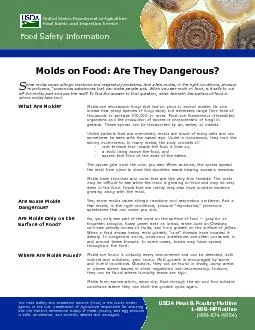/


that the nation146s commercial supply of meat poultry and egg products USDA Photo primarily in grain and nut crops but are also known to be on celeryOrganization FAO of the United Nations est ID: 124297
Download Pdf The PPT/PDF document "Food Safety Information" is the property of its rightful owner. Permission is granted to download and print the materials on this web site for personal, non-commercial use only, and to display it on your personal computer provided you do not modify the materials and that you retain all copyright notices contained in the materials. By downloading content from our website, you accept the terms of this agreement.
Food Safety Information that the nation’s commercial supply of meat, poultry, and egg products USDA Photo primarily in grain and nut crops, but are also known to be on celery,Organization (FAO) of the United Nations estimates that 25% of the“toadstool” (from the German “Todesstuhl” — death’s stool) is commonlyYes, molds are used to make certain kinds of cheeses and can be on thesurface of cheese or be developed internally. Blue veined cheese such as Molds on Food: Are They Dangerous? Molds on Food: Are They Dangerous? Food Safety Information2 Moldy Food: When to Use, When to Discard Luncheon meats,bacon, or hot dogsHard salami and dry-cured country hamsCooked leftover meatand poultryCooked casserolesCooked grain andpastaHard cheese (notcheese where mold ispart of the processing)Cheese made withmold (such asRoquefort, blue,Soft cheese(such ascottage, cream cheese,Neufchatel, chevre, BelPaese, etc.)Yogurt and sourcreamJams and jelliesDiscardUse. Scrub mold off surface.DiscardDiscardaround and below the moldDiscard soft cheeses suchas Brie and Camembert ifDiscardDiscardDiscardFoods with high moisture content can becontaminated below the surface. Moldy foods mayIt is normal for these shelf-stable products to havesurface mold.Foods with high moisture content can becontaminated below the surface. Moldy foods mayFoods with high moisture content can becontaminated below the surface. Moldy foods mayfoods with high moisture content can be contaminatedbelow the surface. Moldy foods may also haveMold generally cannot penetrate deep into theproduct.Molds that are not a part of the manufacturingprocess can be dangerous.Foods with high moisture content can becontaminated below the surface. Shredded, sliced, orFoods with high moisture content can becontaminated below the surface. Moldy foods mayThe mold could be producing a mycotoxin.Microbiologists recommend against scooping out the Molds on Food: Are They Dangerous? Molds on Food: Are They Dangerous? Food Safety Information4 FOODHANDLING REASON